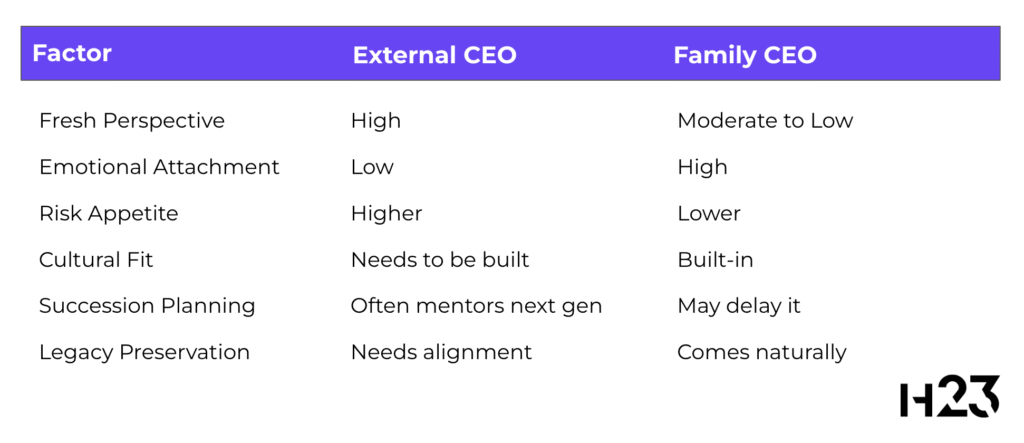When is the right time to bring in someone from the outside?
At some point, every growing family business hits a wall. It could be complexity, scale, succession questions, or simply a tired founder. What worked before stops working. And that’s usually the moment families start thinking: do we need someone new at the top?
Some clear signs it might be time:
Decision-making slows down
There are more mistakes or operational problems
The founder is stretched thin or losing interest
The business needs skills that aren’t in the family today.
Sometimes the signs are subtle – less energy, less urgency, or too much firefighting. Often, families wait too long. From what I’ve seen, it’s rarely too early. But it’s often just a bit too late.
What makes it work when you bring someone in?
Hiring an external CEO isn’t just about experience. It’s about how they fit, how the role is set up, and whether the family is really ready to let go of some control. When it works, it can push the business forward. When it doesn’t, it usually has little to do with strategy and everything to do with trust and clarity.
Here’s what helps make it work:
-
Good onboarding: They need to understand the company’s history, people, and how things really work. That takes time.
-
Clear roles: The family needs to define what they’ll still own: strategy, culture, nothing? and what the new CEO owns.
-
Solid governance: A board, advisors, or even just a trusted sounding board helps avoid power struggles.
-
Shared vision: The CEO and the family should agree on where the business is going. If not, even small decisions get stuck.
-
Ongoing support: Sometimes even experienced outsiders need mentoring in a family business. And the next generation needs it too.
I’ve seen families ask for a change-maker, but secretly hope for someone who won’t rock the boat. That kind of mismatch never ends well.
How do outside CEOs perform compared to family members?
Research shows outside CEOs often outperform family ones, especially when the business needs change, risk-taking, or innovation. They tend to move faster, are less tied to tradition, and usually focus more on performance than emotion.
Family CEOs, on the other hand, are more careful. They protect the brand, the people, the way things are done. That can be great for long-term thinking, but it also slows down bold decisions.
Studies back this up: family leaders are more risk-averse. Especially older ones. They care about preserving wealth and reputation. Outside hires often push harder for growth, because they’re not emotionally attached to the past.
Still, it’s not just about being family or not. Age, background, and experience shape risk appetite too. A young, ambitious family leader might be bolder than an older outside hire. It depends.
And of course, not every outside CEO succeeds. If they don’t get buy-in, if the family stays too involved, or if there’s no clear structure it can fall apart quickly.
What are the other options besides hiring someone external?
Not every family business needs to go outside. In fact, many would rather grow their next leader from within.
Here are other paths that work:
-
Start early: Educate and mentor the next generation. Give them real responsibility over time.
-
Use bridging leadership: Bring in a temporary CEO to steady the business while preparing a family member.
-
Hybrid models: Keep a family chair or board role, and let an external person run daily operations.
From what I’ve seen, hybrid setups work well in older family businesses. They protect the legacy but allow professionals to scale operations.
Don’t mix up management and ownership
This is a simple point but an important one. Just because someone outside is running the business doesn’t mean they own it or control its future.
-
CEO succession is about who leads the business every day
-
Ownership succession is about who holds shares and long-term control.
The most successful transitions often split these two. Families can keep the values and direction, while professionals handle growth and complexity.
When not to bring in someone from the outside
It’s just as important to know when to wait.
Don’t hire a professional CEO if:
-
The family hasn’t agreed on their role going forward
-
There’s no governance in place
-
The job description is vague or keeps changing
-
The real hope is “they’ll fix everything without changing anything”
That’s not a leadership role. It’s a setup for frustration and failure.
Quick comparison: external vs. family CEOs

Bringing in someone from the outside is one of the biggest calls a family business can make. Done right, it can unlock new growth, new energy, and new capabilities. Done wrong, it can create friction that slows everything down.
What matters most is alignment: clear roles, clear governance, and a shared vision. Whether you grow a successor from within, or bring one in, the family still sets the tone. And that tone has to balance tradition with change.
